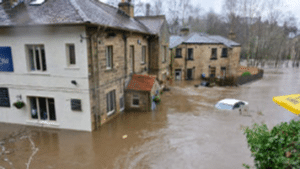
Mold isn’t just unsightly – it’s dangerous to our wellness, too. Besides being gross and slimy, mold also creates irritants, allergens, and, in the worst cases, toxins that can contribute to both minor and major health concerns and issues.
Even the tiniest bit of mold can grow and spread rapidly if left untreated. And although some areas and conditions are more prone to mold growth, it can happen anywhere and on multiple surfaces. Plants, books, clothing, and hardwood floors are some of the more visible places where mold can grow. However, there are just as many places where mold can hide and linger. A small spot of mold on a wall may not seem like a big deal. But taking a look behind that wall may be more alarming.
If you see any amount of mold in your home or business, it’s always best to contact a mold removal specialist such as FloodCo USA to assess the situation and take proper action. However, there are certain steps you can take to help prevent mold from affecting your property and harming its residents.
Remove & Dry Immediately
As if floods weren’t horrible enough, their after-effects can be equally devastating. One of the biggest causes of concern with flood water is its propensity for accelerating mold growth. The longer flood water stays dormant in a property, the greater the risk of serious mold growth.
To help prevent or reduce the risk of harmful mold growth in flooded properties, it’s imperative that the waters be removed and damaged areas are dried out as quickly as possible. Most mold remediation specialists recommend that water removal and drying efforts should take place 24 to 48 hours after flooding occurs. The quicker these actions can be taken, the better the chances for preventing mold growth.
Floods also allow property owners the opportunity to properly address any leaks in the walls, ceilings, or floors that could lead to future water damage and mold growth.
Practice Proper Ventilation
It may not seem obvious, but some common everyday activities could be contributing to mold growth. Everything from taking a shower to washing dishes to doing laundry could be creating enough moisture to produce mold growth. That’s why it’s important to properly ventilate any areas where moisture is present. Open a window or install an exhaust fan in the bathroom to reduce moisture during showers and baths. Crack a window when you run the dishwasher or use a small fan to circulate air in the kitchen. And be sure that the clothes dryer is properly ventilated so that hot moist air finds its way outside the home and doesn’t become trapped inside.
Monitor Humidity Levels
High levels of humidity are catalysts for mold. That’s why it’s important to maintain a suitable level of humidity in your home or workplace to prevent mold from growing. Sometimes it’s easy to identify signs of high moisture levels such as condensation on a window, ceiling, or surface.
Other times, the humidity may not be so significant to see or feel. Investing in an inexpensive digital moisture meter is the best way to monitor your everyday levels. Typically, a household or workplace’s humidity levels should range from 30% to 50% every day all day long. If your property experiences high humidity levels, investing in a dehumidifier may help you maintain more consistent levels.
Use Mold-Resistant Materials
A very effective way to prevent mold growth is to incorporate mold-resistant materials in your next home or office renovation project. Use mold-resistant drywall or sheetrock if you’re building or remodeling a property (especially in areas that are prone to moisture like basements, bathrooms, and kitchens). If you’re considering updating a room or rooms with a new coat of paint, consider adding a mold inhibitor to prevent growth and spread.
By using these tips and investing in these tools, you’ll help reduce opportunities for mold growth in your property. And in turn, you’ll lower the risk of mold exposure to your family and employees. If you suspect that your property is affected by mold growth, FloodCo USA can help. We’re not only specialists in water damage restoration, we’re also experts in mold remediation. Our certified technicians follow all recommended EPA and IICRC guidelines and use state-of-the-art equipment to rid your property of harmful mold. Contact FloodCo USA to learn more about our mold remediation services.



